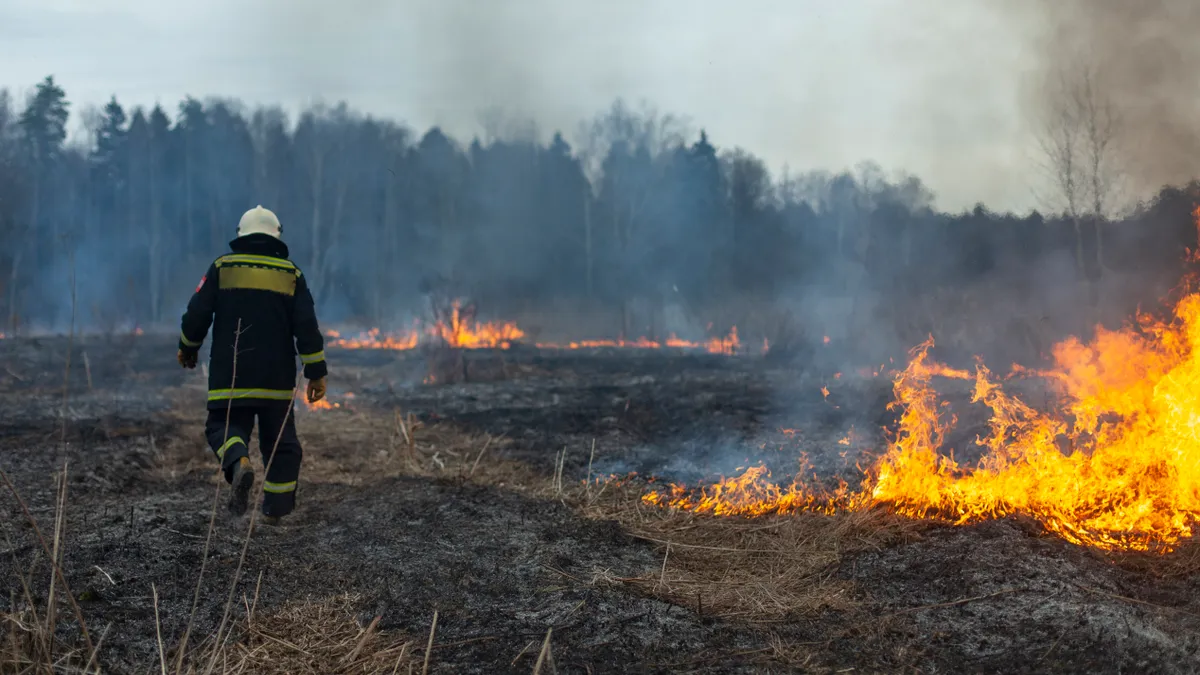Dive Brief:
- Pacific Gas & Electric’s investments in wildfire prevention have given the utility “an entirely different readiness posture and physical risk mitigation regime in place” as it navigates California’s wildfire season this year, PG&E Corp. CEO Patti Poppe told analysts during the company’s second quarter earnings call Thursday.
- The utility has focused on a host of strategies, including burying portions of its power lines, which have reduced the number of ignitions and acres burned in its service territory, it reported in its latest 10-Q filing with the U.S. Securities and Exchange Commission. However, the success of these efforts depends in part on whether PG&E can retain the workforce necessary for these strategies, it said.
- Some stakeholders, however, continue to have concerns about PG&E’s wildfire prevention strategies. April Rose Maurath Sommer, executive and legal director of the Wild Tree Foundation, said the utility has not been focused on the most effective technique for strengthening its infrastructure and preventing it from causing fires, which is installing covered conductors or insulated power lines.
Dive Insight:
PG&E Corp. reported $406 million in income available for common shareholders in the second quarter, compared to $356 million in the same quarter in 2022. The company attributed the increase to lower costs related to the Chapter 11 bankruptcy proceeding that the company underwent in 2019, as well as lower wildfire-related costs.
PG&E filed for bankruptcy in early 2019 after its infrastructure had sparked a series of wildfires in Northern California over the preceding two years, which led to more than 100 fatalities. The utility emerged from bankruptcy after paying out $25.5 billion to settle its wildfire liabilities and has since been investing billions of dollars into upgrading its infrastructure to prevent future fires. The utility plans to spend around $18 billion on fire prevention measures through 2025, according to a plan filed with regulators this March.
California’s wildfire season started off on a relatively mild note this year, the New York Times reported, thanks in part to wet winter months. However, that could change as temperatures across the state stay high, drying vegetation and converting it into fuel.
While the moisture that the state saw in the first quarter of the year could lead to additional fuel, PG&E is ready no matter the conditions, according to Poppe. Since 2017, the utility has installed more than 600 high-definition cameras; set up more than 1,400 weather stations; strengthened 1,300 miles of power lines; transferred around 300 more miles of power lines underground; and removed 3.3 million trees in its footprint, Poppe said.
These strategies have “dramatically changed our risk exposure and the fundamental safety of our system,” she added.
But some stakeholders have raised concerns about PG&E’s wildfire mitigation preparedness, and are pushing instead for more emphasis on installing covered conductors or insulated power lines.
“That’s something that can be done very quickly and can be… highly efficient in preventing ignitions. Their focus instead has been on continued vegetation management and now they’re shifting towards undergrounding,” Maurath Sommer said.
In June, California’s Office of Energy Infrastructure Safety issued a revision notice for the utility’s 2023-2025 wildfire mitigation plan, outlining “critical issues” with PG&E’s strategies. This included the office’s concern that PG&E’s plan to bury power lines underground does not address some of the highest risk areas in its footprint. PG&E reduced its undergrounding targets compared to its original plans from 2022 to 2023, including a 19% decrease for 2023 and a 30% decrease in 2024 through 2026, the notice said. The scaled-back targets “leave some high risk areas without any planned mitigation initiatives,” it noted.
Maurath Sommer said it seems unrealistic that PG&E will be able to bury the miles of power lines it needs to, or says they will do, over the next decade.
“You’re talking about a tenfold increase in how much undergrounding they would be doing in the future versus what they’ve done in the past. They’ve struggled to even be able to have the workforce and the resources to do vegetation management, which is far, far, far simpler” and requires less permitting and money, she said.
Ratepayer group The Utility Reform Network also supports insulating overhead power lines over burying them, saying that the former strategy is faster, safer and cheaper. Burying 10,000 miles of power lines — PG&E’s eventual goal — will take more than a decade, and threaten sensitive environmental habitats, requiring special approvals, the group said in a fact sheet.
“For these reasons, any PG&E undergrounding projects may be delayed for years, or may never be approved at all,” it said.
PG&E spokesperson Matt Nauman, however, said in an email that it is not true that the utility is ignoring the most effective measure of wildfire prevention.
The utility’s “system hardening” initiatives include a host of strategies to deploy equipment that is more resistant to severe weather and that reduces wildfire risk. These include replacing bare power lines with larger, covered lines to reduce the risk of outages caused by vegetation and other factors, according to Nauman.
Since 2018, the utility has completed 978 miles of overhead hardening and is on track to complete another 110 miles this year, Nauman said. It is also on track to bury 350 miles of power lines, nearly double the 180 miles that were put underground in 2022.
“We evaluate each proposed system hardening project with a focus on mitigating the maximum amount of risk effectively and efficiently. Based on the type and condition of the equipment, environmental terrain and surrounding fuel conditions, we determine whether to complete undergrounding or another risk mitigation such as overhead hardening,” he said, adding that burying power lines provides the highest level of risk reduction at the lowest long-term cost to customers.
Editor’s Note: We’ve updated this story with additional comments from PG&E.















